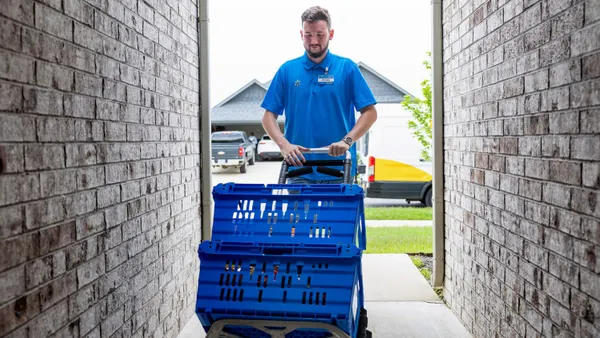Dive Brief:
- Amid a rapidly evolving trade landscape, Wayfair CEO Niraj Shah on Tuesday said, “we really have not seen any consumer behavior based on tariffs.”
- “The only instances of pull forward we've identified came from a very short-lived increase in large appliances demand back in the early spring, and a similarly short-lived increase in vanities late in the third quarter. Neither of these moves the aggregate in a meaningful fashion,” Shah said on a call discussing the retailer’s third-quarter earnings results.
- Wayfair reported Q3 revenue increased 8.1% year over year to $3.1 billion, with U.S. revenue increasing 8.6% to $2.7 billion.
Dive Insight:
Wayfair executives remained optimistic despite industrywide tariff-induced headwinds and weak consumer sentiment.
“The strength we’re seeing overall comes from the structural business initiatives we have, not pull forward,” Shah said. “We’re continuing to see good momentum on the structural business initiatives — and those are things we control.”
The retailer’s revenue growth was primarily driven by order momentum, with orders delivered increasing 5.4% year over year to 9.8 million.
Repeat customers placed over 80% of total orders delivered in the quarter, and average order value increased to $317 from $310 in the same period last year. But Wayfair’s active customer base continues to shrink, reaching 21.2 million, down 2.3% year over year.
The retailer’s losses also widened during the quarter, with net loss standing at $99 million from $74 million last year. Wayfair’s long-term debt is now $2.7 billion, down slightly from the year-ago period.
The results came as the broader home sector grapples with a housing market that remains weak.
“The problem with a softening market is that it does not serve Wayfair’s needs,” GlobalData Managing Director Neil Saunders said in emailed comments. “The company has what can most favorably be described as a very fragile business model that is poor at producing profit. Fast growth helps to mask this and nudges the numbers in the right direction; without that dynamic the model falters.”
The muted housing market is paired with the fact that new tariff policies are increasingly targeting the home sector, affecting many products Wayfair sells.
“The market will become more challenging, costs will come under pressure from tariffs, competition is intensifying, and Wayfair is still sitting on a huge debt pile,” Saunders said. “It will take a lot more cutting and a lot more growth to balance this equation and we see the possibility of achieving this as slim.”
Looking ahead, Wayfair expects fourth-quarter revenue to be up in the mid-single-digits year over year, which includes a 100-basis-point hit from its exit from Germany announced earlier this year.















